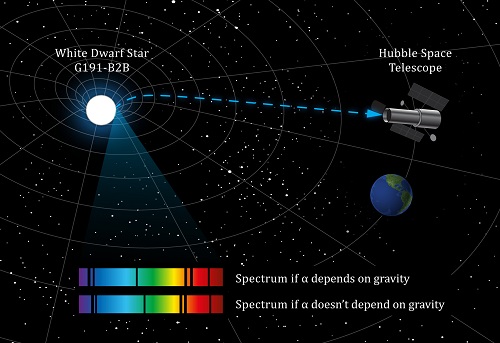White dwarf star throws light on constant of Nature
July 5, 2013

Studying a distant star to test a controversial theory (credit: University of New South Wales)
University of New South Wales (UNSW) physicists are studying a distant star where gravity is more than 30,000 times greater than on Earth to test their controversial theory that α (alpha) — also known as the fine-structure constant — is not a constant.
“If alpha [the fine-structure constant] were bigger than it really is, we should not be able to distinguish matter from ether [the vacuum, nothingness], and our task to disentangle the natural laws would be hopelessly difficult. The fact however that alpha has just its value 1/137 is certainly no chance but itself a law of nature. It is clear that the explanation of this number must be the central problem of natural philosophy.” — Max Born, cited by A.I. Miller in Deciphering the Cosmic Number: The Strange Friendship of Wolfgang Pauli and Carl Jung, W.W. Norton & Co, 2009
In 1999, a team led by John K. Webb of the University of New South Wales claimed the first detection of a variation in α Now Dr. Julian Berengut of the UNSW School of Physics and his international team are using the Hubble Space Telescope to measure the strength of α more accurately on a white dwarf star.
“A white dwarf star was chosen for our study because it has been predicted that exotic scalar-energy fields could significant alter alpha in places where gravity is very strong,” said Berengut.
“Scalar fields are forms of energy that often appear in theories of physics that seek to combine the Standard Model of particle physics with Einstein’s general theory of relativity. By measuring the value of alpha near the white dwarf and comparing it with its value here and [at the present time] in the laboratory, we can indirectly probe whether these alpha-changing scalar fields actually exist.”
White dwarfs are very dense stars near the ends of their lives. The researchers studied the light absorbed by nickel and iron ions in the atmosphere of a white dwarf called G191-B2B. “This absorption spectrum allows us to determine the value of alpha with high accuracy. We found that any difference between the value of alpha in the strong gravitational field of the white dwarf and its value on Earth must be smaller than one part in ten thousand,” Dr Berengut says.
“This means any scalar fields present in the star’s atmosphere must only weakly affect the electromagnetic force.”
Berengut said that more precise measurements of the iron and nickel ions on earth are needed to complement the high-precision astronomical data. “Then we should be able to measure any change in alpha down to one part per million. That would help determine whether alpha is a true constant of Nature, or not.”
The team includes Professor Victor Flambaum, Professor John Webb and Andrew Ong from UNSW, Professor John Barrow from the University of Cambridge, Professor Martin Barstow and Simon Preval from the University of Leicester and Jay Holberg from the University of Arizona.
By the anthropic principle, a controversial argument of why the fine-structure constant has the value it does, stable matter, and therefore life and intelligent beings, could not exist if its value were much different. For instance, were α to change by 4%, stellar fusion would not produce carbon, so that carbon-based life would be impossible. If α were > 0.1, stellar fusion would be impossible and no place in the universe would be warm enough for life as we know it.